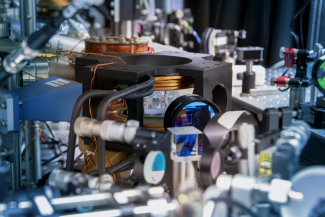Adam Kaufman
Moretsky
Nate is an undergraduate student at CU Boulder, studying engineering physics and electrical engineering. He has a strong interest in Quantum Science, particularly in solid-state physics and quantum technology applications. He is keen on exploring how fundamental quantum principles can be harnessed for practical devices. Nate joined the Kaufman group as an intern on the strontium experiment, and looks forward to working with quantum metrology and simulation.
Drouin
Before joining the Kaufman Group, Jack completed his undergraduate degree in Baltimore at Johns Hopkins. There, he quickly became fascinated with many-body physics, leading him to work in experimental condensed matter under Prof. Collin Broholm. Using neutron scattering, he investigated quantum magnetism and superconductivity and even tried to synthesize some novel materials. His path to AMO began the first time he heard about optical tweezers. After two years of imaging materials with scattering, the opportunity to catch individual atoms in the catch was too good to pass up.
Weiss
Alison graduated from Amherst College with a degree in Physics and Computer Science. During college, she gained exposure to several areas of physics. She worked on topological photonics research in Mikael Rechtsman's group at Penn State and on an antihydrogen hyperfine structure measurement experiment at CERN. For her undergraduate thesis, she characterized and mitigated various sources of error on Professor Larry Hunter's long-range spin-spin interaction precision measurement experiment.
Marsh
Brendan investigates many-body quantum physics with ultracold atoms and photons to realize novel quantum systems and harness them for practical or computational benefit. Before joining JILA as a post-doctoral researcher with Prof. Adam Kaufman and Prof. Cindy Regal, he completed his Ph.D. with Prof. Benjamin Lev at Stanford in the area of multimode cavity QED.
Harle
Nikhil completed his undergraduate degree in intensive physics at Yale, where he worked with Peter Schiffer and Michel Devoret on projects studying emergent order in artificial spin ice systems and fundamental paradigms of quantum mechanics (in addition to a brief foray into COVID-19 misinformation during the pandemic). After working on projects implementing digital quantum simulations at IBM, Nikhil started his PhD at UChicago under Hannes Bernien, where he worked on a second generation dual-species tweezer array before transferring to JILA.
Welsch
Owen is an undergraduate student studying physics and computer science at CU Boulder. He is interested in quantum information science and using computational tools to advance our understanding of fundamental processes. He likes applying problem solving techniques from these subjects to design challenges in areas such as robotics. He joined the Kaufman lab as an intern on the Lithium quantum gas microscope experiment. Through this opportunity he has enjoyed learning about atomic physics, quantum simulation, and experimental design.
Baumgaertner
Alex joined the Kaufman group as a postdoctoral researcher after completing his PhD in the group of Prof. Tilman Esslinger at ETH Zurich, where he explored topological and dissipative phenomena in a degenerate rubidium Bose-Einstein condensate coupled to ultrahigh-finesse cavity modes. His passion for tabletop AMO experiments began during his undergraduate studies at the University of Heidelberg, where he worked in the lab of Prof.




